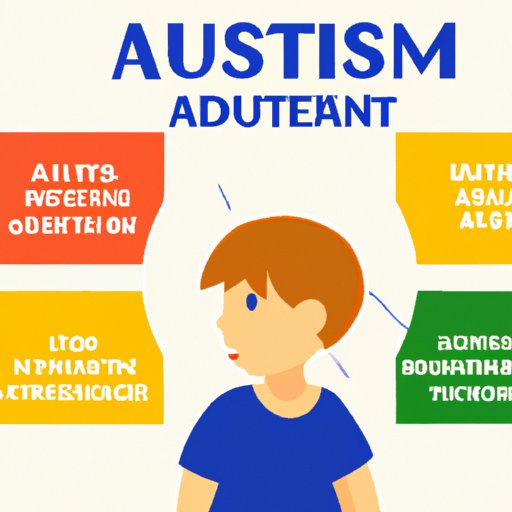I. Introduction
Getting an autism diagnosis is crucial for individuals on the spectrum and their families or caregivers. An accurate diagnosis can help a person understand their strengths and challenges and provide access to the best possible support and resources. This article will provide an overview of the diagnostic process for autism spectrum disorder (ASD), including information on the different professionals who can diagnose autism, tools and tests used, signs and symptoms of autism, the diagnostic process, tips for preparing for the evaluation, common barriers to diagnosis, and common misconceptions about autism testing.
II. Different Professionals Who Can Diagnose Autism
There are several types of healthcare professionals who can diagnose autism, including developmental pediatricians, clinical psychologists, and psychiatrists. Developmental pediatricians are pediatricians with additional training in child development and behavior. Clinical psychologists have expertise in assessing and diagnosing psychological disorders, while psychiatrists are trained medical doctors with expertise in mental health. Each professional has unique qualifications and training in the diagnosis of autism and related conditions.
III. Tools and Tests Used in Autism Diagnosis
To diagnose autism, healthcare professionals may use a combination of tools and tests, including the Autism Diagnostic Observation Schedule (ADOS), the Childhood Autism Rating Scale (CARS), and the Diagnostic and Statistical Manual of Mental Disorders (DSM-5). The ADOS is a standardized assessment that measures social communication, play, and restricted and repetitive behaviors. The CARS is an observational tool that rates different aspects of behavior to identify autistic features. The DSM-5 is a widely-used diagnostic manual that provides a list of criteria for autism diagnosis. These tools and tests provide valuable information about a person’s behaviors, interests, and abilities, which can be used to determine whether they meet the criteria for an autism diagnosis.
IV. Signs and Symptoms of Autism
Autism is a complex neurological condition that affects social communication, interaction, and behavior. Common signs and symptoms of autism may include difficulties with social interaction and communication, repetitive and stereotyped behaviors, sensory processing issues, and others. It’s important to get tested if you suspect your child or loved one may be on the autism spectrum, as early diagnosis and intervention can make a significant difference in their quality of life. It’s essential to understand that signs and symptoms of autism can differ in individuals.
V. The Diagnostic Process
The diagnostic process for autism can be lengthy and involves multiple steps. It typically begins with an initial assessment by a healthcare professional, who will gather information about the person’s medical history, developmental milestones, and current symptoms. From there, the professional may use various tools or tests to assess the person’s skills and behaviors further. After the evaluation, the healthcare professional will provide a definitive diagnosis if they believe the person meets the criteria for autism spectrum disorder. The entire process from the initial assessment to diagnosis may take several weeks or even months depending on the availability of healthcare professionals and testing facilities.
VI. Preparing for the Diagnostic Evaluation
Preparing for the diagnostic evaluation is essential for obtaining an accurate diagnosis. You can prepare for the evaluation by gathering relevant information, such as developmental milestones, medical history, report cards, and other documentation. It’s also essential to communicate effectively with the healthcare provider by asking questions, providing complete information, and being open to the healthcare provider’s suggestions.
VII. Barriers to Autism Diagnosis
Several barriers may prevent individuals from receiving a timely autism diagnosis. Long wait times to see healthcare professionals, a lack of specialists in some areas, and cost concerns are common barriers to diagnosis. It’s essential to acknowledge these challenges and work to develop solutions, such as increasing the availability of healthcare professionals or providing funding for diagnostic testing.
VIII. Common Misconceptions About Autism Testing
There are many misconceptions about autism testing. One common misconception is that a positive diagnosis is necessarily a negative thing. While an autism diagnosis can be challenging, it also presents an opportunity to identify unique strengths and provide support that can help a person lead a fulfilling life. Another common misconception is that autism diagnosis is only for children. However, autism can be diagnosed at any age, and the earlier the diagnosis, the better for accessing appropriate support and resources.
IX. Conclusion
Getting an accurate autism diagnosis is a crucial step in accessing support and resources that can significantly improve a person’s quality of life. By understanding the different professionals who can diagnose autism, tools and tests used in autism diagnosis, signs and symptoms of autism, diagnostic process, preparing for the evaluation, barriers to diagnosis, and common misconceptions about autism testing, individuals and their families can be better equipped to navigate the diagnostic process. By seeking support and resources, regardless of the diagnosis outcome, you can help a person with autism reach their full potential.
